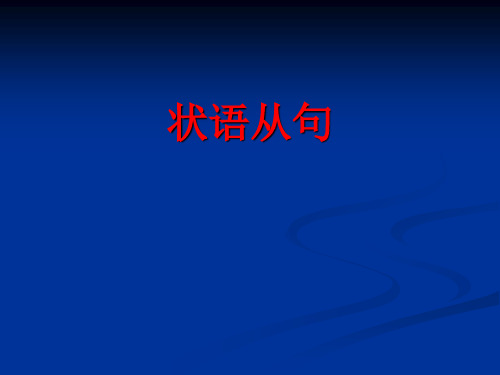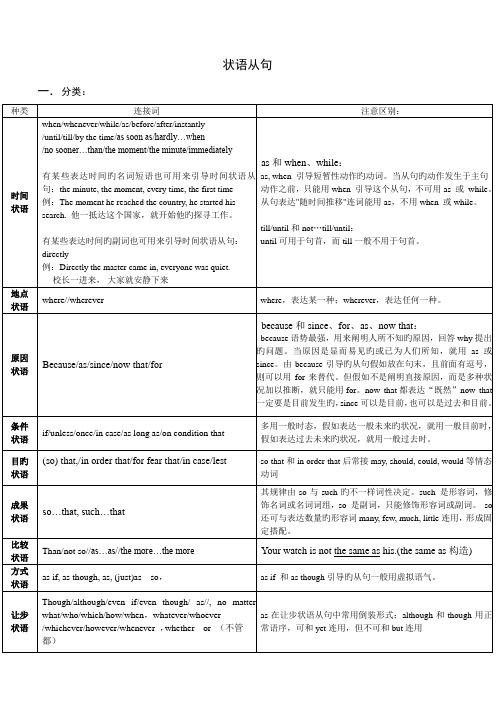高中英语语法大全 状语从句
高中英语语法课件_状语从句 (共42张PPT)

whether…or…
whether…or…引导的让步状语从句: △ 这种从句也称“选择条件-让步状语从句”,可位于 主句之前或之后,如: 1.Whether you like it or not, you’ll have to do it. 2. We hold that all countries, (whether they are) big or small, (whether they are) rich or poor, should be equal. 3. Whether it rains or snows, I will go tonight. 5. She had to go, whether or not she wanted it.
2) 一些表示时间的名词词组也可引
导时间状语从句。如:the moment, the minute, (一…就)next time (下次), every/each time (每 次)。 e.g. The moment he comes, I will tell him.
4) as soon as, immediately, directly, instantly 等副词也可引 导状语从句。表示“一…… 就……”。
.
1. I was so familiar with him that I recognized his voice ______ I picked up the phone. A. while B. after C. In case D. the minute 2. How long do you think it will take _______ our product becomes popular with the consumers? A. when B. until C. before D. since
高中英语语法总结之状语从句(共37张ppt)

• Difficulties are nothing if we are not afraid of them.如果我们不怕困难,困难就算不了什 么了。
• We shall go there tomorrow unless it rains. = We shall go there tomorrow if it doesn’t rain. 除非下雨,我们明天就去那里。
• Every time I travelled by boat, I got seasick.我 每次乘船都晕船。
• The moment I heard the song, I felt cheerful. 我一听到这首歌,就感到很愉快。
• Next time you come ,you’ll see him.下次你来 的时候,就会见到他。
• We were not tired though (although) we had worked all day.虽然我们干了一天活,但并 不累。
• (2)even if, even though(even if 和even though的意思为“即使”“纵使”有退一步 设想的意味,多用于书面语中)。
• 5、结果状语从句:
• (1)so that,so…that(so that前有逗号为 结果状语从句,so…that的so后面跟形容词 或副词)。
• We turned up the radio, so that everyone heard the news.我们把收音机的音量放大, 大家都听到了新闻。
• Seeing (that) he was badly ill, we sent for the doctor.鉴于他病情严重,我们派人去请医生 去了。
(完整版)状语从句知识点大全

(完整版)状语从句知识点大全状语从句是一个句子做另一个句子的状语,用于描述、限制、补充或解释主句的动作或状态。
在英语语法中,状语从句非常常见且广泛应用。
以下是状语从句的一些常见知识点:1. 时间状语从句(Time Adverbial Clauses):用来表示时间,常用的引导词有when, while, as, before, after, until, since等。
例如:I will call you when I arrive home.翻译:我到家时会打电话给你。
2. 地点状语从句(Place Adverbial Clauses):用来表示地点,常用的引导词有where, wherever等。
例如:She can't find her keys anywhere.翻译:她无论到哪儿都找不到她的钥匙。
3. 原因状语从句(Cause Adverbial Clauses):用来表示原因,常用的引导词有because, since, as, for等。
例如:I didn't go to the party because I was tired.翻译:因为我累了,所以我没有去参加聚会。
4. 结果状语从句(Result Adverbial Clauses):用来表示结果,常用的引导词有so, therefore, thus等。
例如:He studied hard, so he passed the exam.翻译:他努力研究,所以他通过了考试。
5. 条件状语从句(Condition Adverbial Clauses):用来表示条件,常用的引导词有if, unless, provided that等。
例如:If it rains tomorrow, we won't go to the park.翻译:如果明天下雨,我们不会去公园。
6. 目的状语从句(Purpose Adverbial Clauses):用来表示目的,常用的引导词有so that, in order that等。
高中英语语法总结-状语从句

状语从句状语从句是一种副词性从句,通常由一个从属连词或一个起连词作用的词组引导。
状语从句1. 时间状语从句常见的连词(组):when, while, as, before, after, once, till, until, as soon as, now that, hardly ...when, scarcely ...when, no sooner ...than等。
可以引导时间状语从句的副(介)词(短语)或名词短语:directly, instantly, immediately, by the time, the moment, the second, the minute, the instant, every time, each time, next time, the last time等。
注意点如下:(1) when, while, as引导的时间状语从句as表示“当……的时候”,往往和when/ while通用,但它着重强调主句与从句的动作或事情同时或几乎同时发生。
when(at or during the time)既可以表示在某一点的时候,又可以表示在某一段时间内,主句与从句的动作或事情可以同时发生也可以先后发生。
while强调一段时间,仅表示从句和主句的动作同时发生,并且有延续意义,该从句中的动词一般要用延续性动词,从句中常用过去进行时态或一般过去时态;当when表示a period of time时,两者可以互换。
She came up as I was cooking.(同时)在我做饭时,她走了过来。
When we were at school, we went to the library every day.(在一段时间内)当我们在学校时,每天都去图书馆。
While they were watching TV, I was preparing myself for the coming examination.他们在看电视,而我在为即将到来的考试做准备。
完整版)高中状语从句归纳

完整版)高中状语从句归纳状语从句是在句子中做状语的,包括时间、条件、让步、原因、目的、结果、比较、地点、方式状语从句。
时间状语从句可以由when、as、while、until、not…until、before、after、since、the minute、the moment、each (every。
next。
the first) time等引导。
在时间状语从句中,一般使用一般现在时或一般过去时来表达。
1.时间状语从句引导词当句子中有时间状语从句时,可以用when、as、while、until、not…until、before、after、since、the minute、the moment、each (every。
next。
the first) time等来引导。
这些引导词在句子中的使用有不同的侧重点和用法。
1.1 when当我们用when引导时间状语从句时,它的主语和主句的主语相同。
如果从句的谓语动词是be动词,那么从句的主语和be可以省略。
例如:When I arrived home。
I had a little rest.1.2 asas不仅可以表示“当。
的时候”,还可以表示“一面。
一面”和“随着”的意思。
例如:XXX(一面。
一面)You will XXX(随着)1.3 whileXXX表示“当。
的时候”,强调主句的动作和从句的动作同时发生。
从句一般使用进行时,动词必须是延续性动词。
例如:While we were working。
they were having a rest.While they were having a n。
they got very confused.注意:while也有对比的含义,可以解释为“然而”。
例如:XXX。
XXX.2.until和not。
untiluntil和not。
until都表示“直到。
才”。
在肯定句中,主句常用延续性动词;在否定句中,主句常用短暂性动词。
高中英语语法专题系列:状语从句

2)while
while侧重主句的动作发生在从句的时间之间,且从句的动 词必须是持续性的。 while+持续性动词 While we were chatting ,she was looking at the time table on the wall. While I slept, a thief broke in.
3)as
as表示 一边…一边…,强调从句和主句中两个动作交 替进行或同步进行。 Sometimes I watch TV as I am having breakfast.(一边...一边...) as表示随着,此用法不用when或while替 As spring warms the earth, all flowers begin to bloom. (随着)
状语从句定义
在复合句中担任状语成分的从句称为状语 从句,修饰主句的谓语动词,形容词或副 词等。
1. 时间状语从句
2. 地点状语从句 3. 原因状语从句
状语从句分类
4. 条件状语从句
5. 让步状语从句 6. 目的状语从句 7. 结果状语从句 8. 方式状语从句 9. 比较状语从句
1. 时间状语从句
经典例题
1. I was so familiar with him that I recognized his voice ______ I picked up the phone. A.while B. after C. In case D. the minute 答案:D 2. How long do you think it will take _______ our product becomes popular with the consumers? A.when B. until C. before D. since 答案:C
状语从句用法总结计划完整

一、时间状语从句时间状语从句用来表示时间关系,常由连词“当……时候”、“随着”、“一旦”、“随时”、“直到”、“自从”等引导。
例如:1.当我在家里的时候,我妈妈总是在旁边看着我。
2.随着天气的转暖,我们就可以去郊游了。
3.一旦你有了问题,就可以找我帮忙。
4.随时都可以来找我,我随时都在。
5.直到你完成这个任务,我才会离开。
6.自从我来到这个城市,我就没有回过家。
二、地点状语从句地点状语从句用来表示地点关系,常由连词“在……地方”、“位于”、“从……起”、“直至”等引导。
例如:1.在这个超市里,你可以找到各种各样的商品。
2.位于市中心的位置,使得这个商场非常繁华。
3.从这家公司起,我们的合作就一直非常好。
4.直至你找到工作,你就可以安心了。
三、原因状语从句原因状语从句用来表示原因关系,常由连词“因为”、“由于”、“鉴于”等引导。
例如:1.因为我今天不舒服,所以我不想去上课。
2.由于天气的原因,我们取消了郊游计划。
3.鉴于你的表现,老师给了你很高的评价。
四、条件状语从句条件状语从句用来表示条件关系,常由连词“如果”、“只要”、“除非”、“只要……就”等引导。
例如:1.如果明天不下雨,我们就去郊游。
2.只要你能努力,你一定能成功。
3.除非你道歉,否则我不会原谅你。
4.只要你想明白,你就会知道我为什么这样做。
五、目的状语从句目的状语从句用来表示目的关系,常由连词“为了”、“以便”、“好”等引导。
例如:1.为了能更好地学习,他每天都很努力。
2.以便你能理解,我解释得很详细。
3.好让你明白,我特意给你举个例子。
六、结果状语从句结果状语从句用来表示结果关系,常由连词“所以”、“因此”、“结果”、“从而”等引导。
例如:1.所以他没能来,因为他生病了。
2.因此我们决定,明天再去郊游。
3.结果这个方法很有效,我们很快就完成了任务。
4.从而使我们的工作更加顺利。
一、时间状语从句时间状语从句用来表示时间关系,常由连词“当……时候”、“随着”、“一旦”、“随时”、“直到”、“自从”等引导。
完整版)状语从句(9种全)

完整版)状语从句(9种全)状语从句在复合句中起到修饰主句的作用,分为时间、地点、原因、目的、结果、条件、方式、比较、让步等种类。
1.时间状语从句时间状语从句的连接词包括when。
as。
while。
after。
before。
since。
ever since。
as soon as。
once。
till。
until。
whenever。
no sooner…than。
hardly/scarcely。
when。
the moment/minute/instant/second。
every time。
each time。
any time。
the first time。
next time。
last time。
all the time。
by the time。
directly。
immediately。
instantly等。
例如,“一···就···”的句型可以用as soon as或once引导,其中as soon as侧重时间或动作先后衔接紧,而once侧重条件,表示“一旦。
”;on doing sth/on one's + n.作时间状语,例如On arriving at the n。
the thief was arrested.意为“一到达车站,这个小偷就被逮捕了。
”2.地点状语从句地点状语从句的连接词包括where。
wherever。
anywhere。
everywhere等。
例如,I'll go wherever you go.意为“你去哪儿,我就跟你去哪儿。
”3.原因状语从句原因状语从句的连接词包括because。
since。
as。
now that。
seeing that。
considering that等。
例如,Since it's raining。
we'll stay indoors.意为“因为下雨,我们将待在室内。
高考状语从句

高考状语从句一、状语从句的定义与作用状语从句在句子中起副词作用,用来修饰主句中的动词、形容词、副词或整个句子。
它可以表示时间、地点、原因、条件、让步、比较、方式、目的等不同的意义。
二、常见类型及用法1. 时间状语从句- 引导词:when(当……时候),while(在……期间,强调同时性),as (当……;随着),before(在……之前),after(在……之后),since(自从;既然),until/till(直到)等。
- 例如:- When I got home, my mother was cooking.(当我到家的时候,我妈妈正在做饭。
)- While I was reading, he was watching TV.(我读书的时候,他正在看电视。
这里强调读书和看电视这两个动作同时进行)- As we grow older, we become wiser.(随着我们长大,我们变得更聪明了。
)- Before you leave, turn off the lights.(在你离开之前,关灯。
)- After he had finished his homework, he went to bed.(他完成作业之后就去睡觉了。
注意这里从句动作先于主句动作完成,用过去完成时)- Since I came to this school, I have made many friends.(自从我来到这所学校,我交了很多朋友。
since引导的从句常用一般过去时,主句用现在完成时) - He didn't leave until/till his mother came back.(直到他妈妈回来他才离开。
)2. 地点状语从句- 引导词:where(在……地方),wherever(无论在哪里)。
- 例如:- Put the book where you can find it easily.(把书放在你容易找到的地方。
高一语法-状语从句

6. 表示“一---就”的连词有:as soon as ,instantly,immediately,directly,presently , the moment/minute/instant I will give you answer immediately I’ve finished reading your report. The machine will start instantly/the moment you press the button. 7.since“自从” 句型 It is/has been+一段时间+since sb.did sth. 自从某人做某事已经多久了 It is three years since l moved here.我搬到这儿来已经3年了。 8.sb.had hardly done sth.when sb.did sth sb.had no sooner done sth.than sb.did sth. (刚---就---)注意部分倒装形式 He had no sooner got to the lab than he set out to do the experiment 该句倒装结构为: No sooner had he got to the lab than he set out to do the experiment. OR: Hardly had he got to the lab when he set out to do the experiment. 多数情况下都是主倒从不倒
二.条件状语从句
常见连词:unless (if---not),on condition that(在---条件下),providing/provided that (以---为条件,假如),supposing/suppose that(假如,如果,要是),as (so) long as...(只要),in case(万一), as (so) far as就---而言 As long as you promise to keep it well, I will lend the book to you. Supposing/Suppose that I don’t agree to your plan,what will you do? In case my uncle comes/should come,please tell him to wait a moment. The doctor would allow him to go home on condition that he remained in bed. As far as I know, they live in the same neighbourhood. 注意: Only if you practice English more often, are you able to communicate with foreigners. (只要=if 主句要部分倒装) If only few people had been killed in the Iraqi war.(但愿=wish 要用虚拟)
高中英语2025届高考语法复习状语从句知识讲解

高考英语语法复习状语从句知识讲解一、概述常见的有although/though/even though引导的让步状语从句。
if/unless引导的条件状语从句。
until/when/while/as soon as引导的时间状语从句。
because引导的原因状语从句,so that引导的目的状语从句等。
if引导的条件状语从句和when引导的时间状语从句一般都会和时态相结合,即主要考查“主将从现”原则。
对于状语从句的学习可与专题六从属连词相结合。
在时间状语从句和条件状语从句中,主句和从句的时态一致问题一般有两种情况:(1)“主将从现”:主句用一般将来时,而从句用一般现在时。
常见的使用“主将从现”原则的连词有:表示时间的when, while, after, before, until, till, whenever, as soon as, as long as, once 等;表示条件的if, unless, so long as, in case等。
(2)“主祈从现”:若主句是祈使句,或主句中有情态动词时,那么从句用一般现在时表示将来。
(3)“主情从现”:若主句有情态动词, 那么从句用一般现在时表示将来。
如:You can get good grades if you study hard.如果你努力学习,你将取得好成绩。
状语从句由从属连词引导,与主句连接,位于句首时,常用逗号与主句分开,位于句末时,其前一般不用逗号。
状语从句根据其用途可分为时间状语从句、条件状语从句、原因状语从句、目的状语从句、结果状语从句、让步状语从句、比较状语从句、地点状语从句等。
二、时间状语从句(1)当主句是一般将来时态或祈使句,表示将来的意义时,从句通常用一般现在时,简称“主将从现”。
I’ll ring you up as soon as I get to Beijing.我一到北京就给你打电话。
(2) when引导的时间状语从句,通常表示主句和从句的动作同时发生;before表示主句的动作发生在从句的动作之前;after则表示主句的动作发生在从句的动作之后;as引导时间状语从句时,往往表示主句和从句的动作同时发生,不分先后。
2023年高中英语语法状语从句归纳总结

状语从句一.分类:时间状语从句:when (当……旳时候) while (在……期间) as (当……旳时候, 一边……一边……)before (在……之前) since (自从……以来) till/until (直到) hardly…when… (刚……就) as soon as (一……就……)after (在……之后) not…till/until(直到……才)no sooner…than…(刚……就) 地点状语从句:where (在那里) wherever(无论哪里)原因状语从句:because (由于) since (由于,既然) as (由于) for (为了) now that(既然)目旳状语从句:(so)that=in order that(以便)so as(not)to (以便[不])in case(以免)lest(以免)成果状语从句:so+adj./adv.+that(如此……以致)so that(成果……)such+n.+that(假如……以致)that(因此,因此)让步状语从句:though/although不可同but连用。
though/although (虽然)however (可是)even though/if(虽然)no matter+what/which/where/who/when =whatever/whichever/wherever/whoever/whenever(不管什么/哪一种/哪里/谁/何时)比较状语从句:as (正如)as…as(和……同样)not as/so … as (不如……)than(比……更)the+比较级…+the+比较级(越……越……)条件状语从句:if(假设)unless(假如不)so long as(只要)on condition that (假如)方式状语从句:as(像……那样地)just as(正像)as if(仿佛)as though(仿佛)二.多种状语从句旳简化措施:1.以after和before引导旳状语从句旳主语若与主句主语一致时,从句等于after/before+doing sth.作状语。
高中英语语法状语从句

状语从句一般分为九大类 时间状语从句 原因状语从句 目的状语从句 方式状语从句 让步状语从句 地点状语从句 条件状语从句 结果状语从句 比较状语从句
1.时间状语从句:
引导词有 when, whenever, while, as, the moment, the minute , the second, as soon as, immediately , no sooner… than…, hardly…when…,scarcely…when…, every time, each time , by the time , the first time,the last time,next time,once , till, until, since, before, after 等
once 一…就…/一旦…就… Once you see him, you will never forget him. Once you start,you will never give up.
every time, each time 每当 Each time he came to town, he would visit our school.
when 这时
I was about to go to sleep when my sister came in. be on the point of doing when
I was sleeping when my sister came in.
I had just finished my homework when Tom came to visit me. when 既然 How can they expect to learn anything when they never listen ? while(并列连词,“而” 表前后对比) He likes music while I like sports. He is a doctor but he doesn’t like medicine.
最新-列举英语语法状语从句的归纳总结(优秀3篇)

列举英语语法状语从句的归纳总结(优秀3篇)目的状语从句,从句部分是用以补充说明主句中谓语动词发生的目的的状语从句。
下面是壶知道敬业的帮助大家分享的3篇列举英语语法状语从句的归纳总结,欢迎参考阅读,希望对大家有所启发。
. 状语从句:Adverbial clauses 篇一定义:在复合句中由从句表示的`状语称作状语从句,它可以用来修饰谓语(包括非谓语动词)、定语或状语,或是整个句子。
状语从句一般分为八大类时间状语从句地点状语从句原因状语从句目的状语从句结果状语从句条件状语从句方式状语从句让步状语从句1、时间状语从句When ---当……时候,通常指某一特定的时间点,主句与从句的动作同时发生。
When I opened the window, I saw him e up. When ---正在……的时候,突然…。
通常主句是进行时或be about to 时,在翻译的时候,when 可以译成没想到或突然。
I was walking along the street ,when I met hiWhen 当从句是进行时,主句是一般时,往往表示不满。
Someone knocked at the door when I was having breakfast. When=afterWhen the children had gone to bed, she began to prepare her lessons. While ---在……期间,往往指一段时间。
While we were in America, we saw him twice.While ---表示一种不满情绪,意思是这边在干某种重要的事,而另一边在享受等。
We are cleaning the classroom while they are playing the football. As ---一边……一边,随着She was doing her homework as she was listening to the music.As ---当……时,指一个动作紧接着一个动作发生,从句通常用进行时。
高中英语语法 状语从句

状语从句The Examples of Adverbial Clauses状语从句一、时间状语从句when, while, as, whenever, till, until, after, before, since, once, every/each time, the day一...就...1.As soon as2.The moment/minute/second/instant3.Immediately/instantly/directly4.No sooner...than... hardly/scarcely...when...Than/when 后采用一般过去时,主句采用过去完成时,主倒从不倒。
(adv./prep.位于句首,部分倒装)1.when, while, aswhen用法最广,常可代替while和as, as引导的时间状语从句既可以是延续性动词,又可以是非延续性动词;而while所引导的时间状语从句谓语动词只能是延续性动词,并常与进行时态连用。
1). When I lived in the countryside, I used to carry some water for him.2). While my wife was reading the newspaper, I was watching TV.3). As we were going out, it began to snow.when一般强调特定时间,还可表示:1.就在这时/就在那时突然...2.还没...就...3.一...就...4). When spring came, he felt like a trip.5). We were about to to leave when he came in.6). I had hardly sat down when he stepped in.=Hardly had I sat down when he stepped in.While所引导的时间状语从句强调主句和从句的动作同时发生或相对应,也表示对比。
202X年高中英语语法状语从句归纳总结

千里之行,始于足下。
202X年高中英语语法状语从句归纳总结状语从句是英语语法中非常重要的句子结构,用来表达时间、条件、原因、目的、结果等关系。
在高中英语学习中,状语从句是必须掌握的一部分。
下面是关于状语从句的归纳总结:一、时间状语从句1. when/while/as/since/before/after/once(在……以后)/until/till (直到)/as soon as(一……就)/no sooner……than(刚……就)等引导时间状语从句。
2. 引导时间状语从句的词可以放在主句的前面、中间或者后面。
3. 当主句是一般将来时,从句必须使用一般现在时表示将来。
二、条件状语从句1. if/unless(除非)/as long as(只要)/in case(万一)等引导条件状语从句。
2. 条件状语从句可以放在主句的前面或者中间。
3. 当主句是祈使句时,从句中的谓语动词要使用一般现在时表示将来。
三、原因状语从句1. because/since/as(因为)/now that(既然)/due to(由于)/owing to(因为)/for(因为)等引导原因状语从句。
2. 因果关系的句子可以是主从倒装。
四、目的状语从句1. so that/ in order that(为了)等引导目的状语从句。
2. 目的状语从句常出现在含有情态动词或动词不定式的句子中。
第1页/共2页锲而不舍,金石可镂。
五、结果状语从句1. so…that (如此……以至于) /such…that(如此……以至于)等引导结果状语从句。
2. 结果状语从句常与主句之间有\。
高中英语语法状语从句知识点总结

高中英语语法状语从句知识点总结高中英语语法状语从句知识点总结相关例句时间状语从句常用引导词:when, as, while, as soon as, before, after, since , not...until特殊引导词:the minute, the moment, the second, every time, the day,the instant( 瞬间,顷刻), immediately , directly(不久,立即), no sooner … than(一...就...), hardly …when(刚一...就...) , scarcely … when(几乎没有……的时候)I didn’t realize how special my mother was until I became an adult.直到我成为了一个成年人我才意识到我的母亲是多么的特殊。
While John was watching TV, his wife was cooking.当约翰在看电视时,他的妻子正在做饭。
The children ran away from the orchard(果园), the moment they saw the guard.孩子们一看到守卫就逃走了。
No sooner had I arrived home than it began to rain.还没等我到家就开始下雨了。
Every time I listen to your advice, I get into trouble.每当我听取你的建议的'时候,我就会惹上麻烦。
地点状语从句常用引导词:where特殊引导词:wherever, anywhere, everywhereGenerally, air will be heavily polluted where there are factories.一般来说,有工厂的地方空气污染就严重Wherever you go, you should work hard.无论你去哪里,你应该努力工作地点状语从句一般由连接副词where, wherever等引导,已经形成了固定的句型,例如:Where there is no rain, farming is difficult or impossible.在没有雨水的地方,耕作是困难的,或根本不可能的。
高考状语从句知识点

高考状语从句知识点状语从句是高考英语中的一个重要语法点,掌握好状语从句对于理解和运用英语句子结构、提高英语语言能力有着至关重要的作用。
接下来,让我们一起深入了解一下高考中常见的状语从句类型及其用法。
一、时间状语从句时间状语从句表示时间关系,常用的引导词有 when(当……时候)、while(在……期间)、as(当……时;一边……一边……)、before(在……之前)、after(在……之后)、since(自从……)、until / till(直到……)等。
1、 when 引导的时间状语从句When I was a child, I often played in the park(当我还是个孩子的时候,我经常在公园玩耍。
)When he arrived home, it was already midnight(当他到家时,已经是午夜了。
)需要注意的是,when 引导的从句动作可以与主句动作同时发生,也可以先于主句动作发生。
2、 while 引导的时间状语从句While I was doing my homework, my mother was cooking(当我在做作业时,妈妈在做饭。
)While he was reading, his sister was singing(他在读书时,他妹妹在唱歌。
)while 引导的从句动作通常是持续性的,且主句和从句动作同时发生。
3、 as 引导的时间状语从句As I was walking along the street, I met an old friend(当我沿着街道走时,遇到了一位老朋友。
)As time goes by, we become more mature(随着时间的流逝,我们变得更加成熟。
)4、 before 和 after 引导的时间状语从句I had finished my homework before my father came back(在我爸爸回来之前,我已经完成了作业。
高中英语知识点归纳状语从句的用法及常见引导词

高中英语知识点归纳状语从句的用法及常见引导词状语从句是英语中常见的一个语法结构,它可以用来修饰动词、形容词或者副词,表达时间、地点、原因、条件等等不同的语义关系。
在高中英语中,掌握状语从句的用法对于理解和运用复杂的句子结构至关重要。
本文将对状语从句的用法进行归纳,并介绍常见的引导词。
一、时间状语从句1. 引导词:when、while、as、before、after、until等例句:I will call you when I arrive in London.(当我到达伦敦时,我会给你打电话。
)二、地点状语从句1. 引导词:where、wherever例句:I will go wherever you go.(无论你去哪里,我都会去。
)三、条件状语从句1. 引导词:if、unless、on condition that等例句:If it rains tomorrow, we will stay at home.(如果明天下雨,我们会待在家里。
)四、原因状语从句1. 引导词:because、as、since等例句:He didn't come to the party because he was sick.(他因为生病所以没来参加聚会。
)五、目的状语从句1. 引导词:so that、in order that例句:He studies hard so that he can get into a good university.(他努力学习以便能进入一所好大学。
)六、比较状语从句1. 引导词:as、than例句:She is taller than her sister.(她比她妹妹高。
)七、方式状语从句1. 引导词:as、as if/though例句:She danced as if nobody was watching.(她跳舞时仿佛没人在看。
)八、让步状语从句1. 引导词:though、although、even though例句:Though it was raining, they still went hiking.(尽管下雨,他们还是去爬山了。
- 1、下载文档前请自行甄别文档内容的完整性,平台不提供额外的编辑、内容补充、找答案等附加服务。
- 2、"仅部分预览"的文档,不可在线预览部分如存在完整性等问题,可反馈申请退款(可完整预览的文档不适用该条件!)。
- 3、如文档侵犯您的权益,请联系客服反馈,我们会尽快为您处理(人工客服工作时间:9:00-18:30)。
---Until when are you staying? 你呆到什么时候?
--- Until next Monday. 呆到下周一。
注意:否定句可用另外两种句式表示。
1)Not until…在句首,主句用倒装。例如:
Not until the early years of the 19th century did man know what heat is. 直到19 世纪初,人类才知道热为何物。
Always do to the others as you would be done by.你希望人家怎样待你,你就要怎样待人。
As water is to fish, so air is to man. 我们离不开空气,犹如鱼儿离不开水。
Just as we sweep our rooms, so we should sweep backward ideas from our minds.
unless = if not.
例如: Let's go out for a walk unless you are too tired. 如果不太累,我们去散散步。
If you are not too tied, let's go out for a walk.
典型例题
You will be late ___ you leave immediately.
注意:no matter 不能引导主语从句和宾语从句。
8. 比较while, when, as
1)as, when 引导短暂性动作的动词。例如:
Just as / Just when / When I stopped my car, a man came up to me. 我一刹车,有一个人向我走来。
I didn't manage to do it until you had explained how. 直到你教我后,我才会做。
区别:1)until可用于句首,而till通常不用于句首。例如:
Until you told me, I had heard nothing of what happened. 直到你告诉我以前,出了什么事我一点也不知道。
高中英语语法大全 状语从句.txt
高中英语语法大全 状语从句
一.概念
状语从句修饰主句中的动词,形容词,副词等,在复合句中作状语.引导状语从句的关联词是从属连词.状语从句用陈述句语序,一般位于复合句的句首或句末.当从句在句首时,从句后常用逗号和主句相隔.状语从句根据其在句中的不同作用分别表示时间,地点,原因,目的,结果,条件,比较,让步,行为方式等.
正如打扫房屋一样,我们也要扫除我们头脑中落后的东西。
2)as if, as though
两者的意义和用法相同,引出的状语从句谓语多用虚拟语气,表示与事实相反,有时也用陈述语气,表示所说情况是事实或实现的可能性较大。汉译常作"仿佛……似的","好像……似的"。例如:
They completely ignore these facts as if (as though) they never existed. 他们完全忽略了这些事实,就仿佛它不存在似的。(与事实相反,谓语用虚拟语气。)
7. 让步状语从句
1)though, although引导的让步状语从句,后面的从句不能有but,但是 though 和yet可连用。例如:
Although it's raining, they are still working in the field. 虽然在下雨,但他们仍在地里干活。
I didn't go, because I was afraid. 我不去是因为我怕。
Since /As the weather is so bad, we have to delay our journey. 天气那么糟,旅行推迟了。
2)由because引导的从句如果放在句末,且前面有逗号,则可以用for来代替。但如果不是说明直接原因,而是多种情况加以推断,就只能用for。例如:
4)whether…or… 不管……都。例如:
Whether you believe it or not, it is true. 信不信由你,这确实是真的。
5)"no matter +疑问词" 或"疑问词+后缀ever" 。例如:
No matter what happened, he would not mind. =Whatever happened, he would not mind. 不管发生什么,他不在意。
The waves dashed on the rocks as if in anger. 波涛冲击着岩石,好像很愤怒
3.原因状语从句
比较because, since, as和for:
1)because语势最强,用来说明人所不知的原因,回答why提出的问题。当原因是显而易见的或已为人们所知,就用as或 since。例如:
He looks as if (as though) he had been hit by lighting. 他那样子就像被雷击了似的。(与事实相反,谓语用虚拟语气。)
It looks as if the weather may pick up very soon. 看来天气很快就会好起来。(实现的可能性较大,谓语用陈述语气。)
二.相关知识点精讲
1.地点状语从句
地点状语从句通常由where, wherever 引导。例如:
Where I live there are plenty of trees. 我住的地方树很多。
Wherever I am I will be thinking of you. 不管我在哪里我都会想到你。
He is absent today, because / for he is ill. 他今天缺席,因为他病了。
He must be ill, for he is absent today. 他一定病了,所以今天缺席。
4.目的状语从句
表示目的状语的从句可以由that, so that, in order that, lest, for fear that, in case等词引导。例如:
Better take more clothes in case the weather is cold. 最好多穿点衣服,以防天发冷。
5.结果状语从句
结果状语从句常由so…that 或 such…that引导。so…that与such…that之间可以转换。例如:
The boy is so young that he can't go to school. 这男孩年龄太小,不能上学。
He is such a young boy that he can't go to school
6. 条件状语从句
连接词主要有 if, unless, as/so long as, on condition that 等。if 引导的条件句有真实条件句和非真实条件句两种。非真实条件句已在虚拟语气中阐述。
Not until I began to work did I realize how much time I had wasted. 直到工作,才认识到我已蹉跎了几多岁月。
2)It is not until… that… 。例如:
It was not until I began to work that I realized how much time I had wasted.
替换:no matter what = whatever
no matter who = whoever
no matter when = whenever
no matter where = wheቤተ መጻሕፍቲ ባይዱever
no matter which = whichever
no matter how = however
You must speak louder so that /in order that you can be heard by all. 你必须大点声,别人就能听见了。
He wrote the name down for fear that(lest) he should forget it. 他写下了这个名字以免以后忘记。
说明:as if / as though也可以引导一个分词短语、不定式短语或无动词短语。例如:
He stared at me as if seeing me for first time. 他目不转睛地看着我,就像第一次看见我似的。
He cleared his throat as if to say something. 他清了清嗓子,像要说什么似的。
As the day went on, the weather got worse. 日子一天天过去,天气越变越坏。
9.比较until和till
此两个连词意义相同。肯定形式表示的意思是"做某事直至某时",动词必须是延续性的。否定形式表达的意思是"直至某时才做某事"。动词为延续性或非延续性都可以。正确使用这两个连词的关键之一就在于判断句中的动词该用肯定式还是否定式。肯定句:I slept until midnight. 我一直睡到半夜时醒了。
2.方式状语从句
方式状语从句通常由as, (just) as…so…,as if, as though引导。
